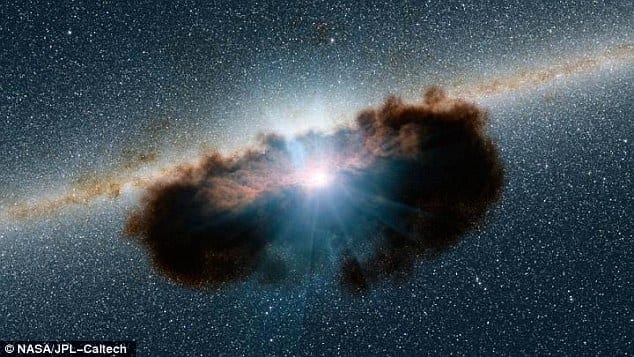As long as singularities stay hidden behind an event horizon, they do not cause trouble and general relativity holds
Markus Kunesch
Researchers have shown how a bizarrely shaped black hole could cause Einstein’s general theory of relativity, a foundation of modern physics, to break down. However, such an object could only exist in a universe with five or more dimensions.
The researchers, from the University of Cambridge and Queen Mary University of London, have successfully simulated a black hole shaped like a very thin ring, which gives rise to a series of ‘bulges’ connected by strings that become thinner over time. These strings eventually become so thin that they pinch off into a series of miniature black holes, similar to how a thin stream of water from a tap breaks up into droplets.
Ring-shaped black holes were ‘discovered’ by theoretical physicists in 2002, but this is the first time that their dynamics have been successfully simulated using supercomputers. Should this type of black hole form, it would lead to the appearance of a ‘naked singularity’, which would cause the equations behind general relativity to break down. The results are published in the journal Physical Review Letters.
General relativity underpins our current understanding of gravity: everything from the estimation of the age of the stars in the universe, to the GPS signals we rely on to help us navigate, is based on Einstein’s equations. In part, the theory tells us that matter warps its surrounding spacetime, and what we call gravity is the effect of that warp. In the 100 years since it was published, general relativity has passed every test that has been thrown at it, but one of its limitations is the existence of singularities.
A singularity is a point where gravity is so intense that space, time, and the laws of physics, break down. General relativity predicts that singularities exist at the centre of black holes, and that they are surrounded by an event horizon – the ‘point of no return’, where the gravitational pull becomes so strong that escape is impossible, meaning that they cannot be observed from the outside.
“As long as singularities stay hidden behind an event horizon, they do not cause trouble and general relativity holds – the ‘cosmic censorship conjecture’ says that this is always the case,” said study co-author Markus Kunesch, a PhD student at Cambridge’s Department of Applied Mathematics and Theoretical Physics (DAMTP). “As long as the cosmic censorship conjecture is valid, we can safely predict the future outside of black holes. Because ultimately, what we’re trying to do in physics is to predict the future given knowledge about the state of the universe now.”
But what if a singularity existed outside of an event horizon? If it did, not only would it be visible from the outside, but it would represent an object that has collapsed to an infinite density, a state which causes the laws of physics to break down. Theoretical physicists have hypothesised that such a thing, called a naked singularity, might exist in higher dimensions.
“If naked singularities exist, general relativity breaks down,” said co-author Saran Tunyasuvunakool, also a PhD student from DAMTP. “And if general relativity breaks down, it would throw everything upside down, because it would no longer have any predictive power – it could no longer be considered as a standalone theory to explain the universe.”
We think of the universe as existing in three dimensions, plus the fourth dimension of time, which together are referred to as spacetime. But, in branches of theoretical physics such as string theory, the universe could be made up of as many as 11 dimensions. Additional dimensions could be large and expansive, or they could be curled up, tiny, and hard to detect. Since humans can only directly perceive three dimensions, the existence of extra dimensions can only be inferred through very high energy experiments, such as those conducted at the Large Hadron Collider.
Einstein’s theory itself does not state how many dimensions there are in the universe, so theoretical physicists have been studying general relativity in higher dimensions to see if cosmic censorship still holds. The discovery of ring-shaped black holes in five dimensions led researchers to hypothesise that they could break up and give rise to a naked singularity.
What the Cambridge researchers, along with their co-author Pau Figueras from Queen Mary University of London, have found is that if the ring is thin enough, it can lead to the formation of naked singularities.
Learn more: Five-dimensional black hole could ‘break’ general relativity
The Latest on: General theory of relativity
[google_news title=”” keyword=”general theory of relativity” num_posts=”10″ blurb_length=”0″ show_thumb=”left”]
via Google News
The Latest on: General theory of relativity
- A 'cosmic glitch' in gravityon May 1, 2024 at 10:35 am
Researchers have discovered a potential 'cosmic glitch' in the universe's gravity, explaining its strange behavior on a cosmic scale.
- A 'cosmic glitch' in gravity: New model may explain strange behavior on a cosmic scaleon May 1, 2024 at 8:04 am
A group of researchers at the University of Waterloo and the University of British Columbia have discovered a potential "cosmic glitch" in the universe's gravity, explaining its strange behavior on a ...
- Euclid telescope: Scientist reports on his quest to understand the nature of dark matter and dark energyon May 1, 2024 at 7:47 am
Fortunately, nature has provided a convenient way forward: Einstein's theory of general relativity tells us that matter curves the space around it. Clumps of dark matter reveal their presence by ...
- NASA's TESS exoplanet hunter may have spotted its 1st rogue planeton April 30, 2024 at 10:01 am
"Definitely a ten out of ten excitement from me. The potential of discovering something like a rogue world drifting in the darkness of interstellar space is just incredible." ...
- The Mysterious ‘Dark’ Energy That Permeates the Universe Is Slowly Erodingon April 28, 2024 at 4:00 am
Physicists call the dark energy that drives the universe “the cosmological constant.” Now the largest map of the cosmos to date hints that this mysterious energy has been changing over billions of ...
- Tweak to Schrödinger's cat equation could unite Einstein's relativity and quantum mechanics, study hintson April 26, 2024 at 2:00 am
Physicists have proposed modifications to the infamous Schrödinger's cat paradox that could help explain why quantum particles can exist in more than one state simultaneously, while large objects ...
- AI Starts to Sift Through String Theory’s Near-Endless Possibilitieson April 24, 2024 at 7:29 am
Using machine learning, string theorists are finally showing how microscopic configurations of extra dimensions translate into sets of elementary particles — though not yet those of our universe.
- Explosive black hole flare from the center of our galaxy reconstructed from 'a single flickering pixel' using AI and Einstein's equationson April 23, 2024 at 10:41 am
An explosive flare from the Milky Way's central black hole has been translated from 'a single flickering pixel' into a detailed 3D model using AI and Einstein's general relativity equations.
- Physicists Say The Ultimate Battery Could Harness The Power of Black Holeson April 21, 2024 at 3:01 am
The quest to generate more energy from less material while avoiding burning any more fossil fuels than our planet can handle is spawning some, let's say, creative ideas.
- Could JWST Solve One of Cosmology's Greatest Mysteries?on April 19, 2024 at 8:00 am
The telescope's studies could help end a long-standing disagreement over the rate of cosmic expansion. But scientists say more measurements are needed ...
via Bing News











